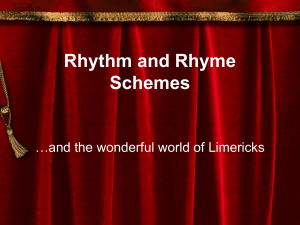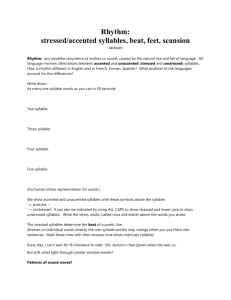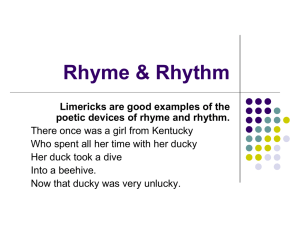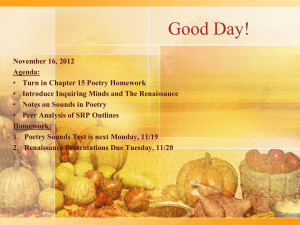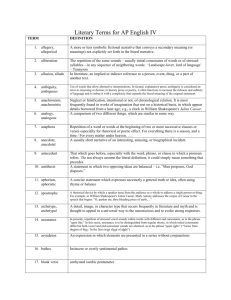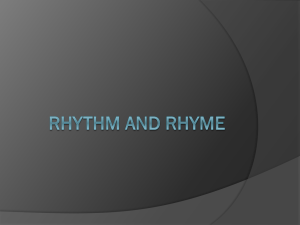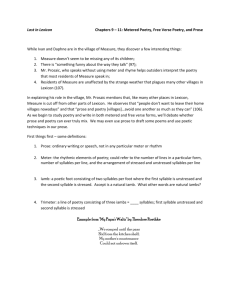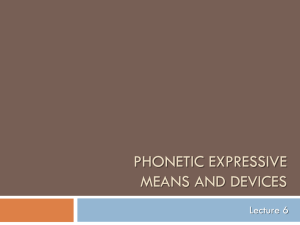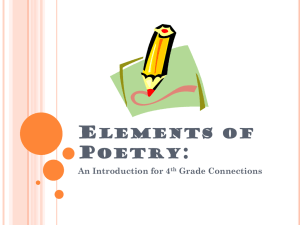4 British Literature
advertisement
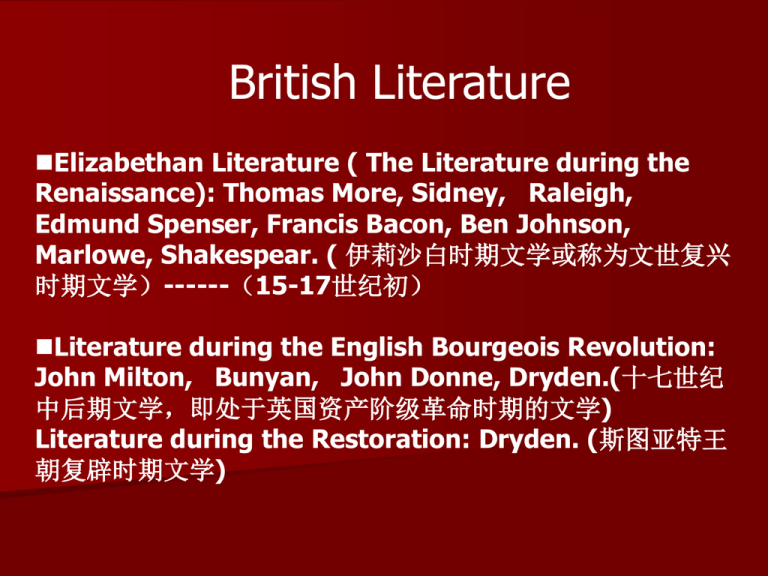
British Literature Elizabethan Literature ( The Literature during the Renaissance): Thomas More, Sidney, Raleigh, Edmund Spenser, Francis Bacon, Ben Johnson, Marlowe, Shakespear. ( 伊莉沙白时期文学或称为文世复兴 时期文学)------(15-17世纪初) Literature during the English Bourgeois Revolution: John Milton, Bunyan, John Donne, Dryden.(十七世纪 中后期文学,即处于英国资产阶级革命时期的文学) Literature during the Restoration: Dryden. (斯图亚特王 朝复辟时期文学) 十八世纪初期文学,即处于欧洲启蒙运动时 期文学; Addison, Steele, Pope, Swift. (Classicism: 古典主义文学) 十八世纪前半叶小说的兴起: Defoe, Fielding, Richardson, Johnson, Boswel, Smollet, Sterne, Goldsmith, Gibbon, Thmas Gray, Blake, Burns. 十八世纪后半叶的文学; Wordworth, Coleridge, Southy( Lake Poets), Byron, Shelley, Keats, Willam Hazlitt, Leigh Hunt, De Quiency, Scott. 十九世纪前期批判现实主义文学: Dickens, Thackeray, Austen, Brotte Sisters, George Eliot, Mrs Gaskell. English Literary History English Language Anglo-Saxon Paraphrase of the Bible (The Book of Kells)凯尔经 Old English (AD450-1150 ) Beowulf Middle English Geoffrey Chaucer The Canterbury Tales (1150-1500 ) Renaissance William Shakespeare 莎士比亚故居 第一时期(1590~1600年) 以写作历 史剧、喜剧为主,有9部历史剧、10部喜剧 和2部悲剧。 10部喜剧《错误的喜剧》、《驯悍记》、 《维洛那二绅士》、《爱的徒劳》、《仲 夏夜之梦》、《威尼斯商人 》、《 温莎的 风流娘儿们 》、《无事生非》、《皆大欢 喜》和《第十二夜》大都以爱情、友谊、 婚姻为主题 第二时期(1601~1607年) 以悲剧为主 ,写了3部罗 马剧、5部悲剧和3部“阴暗的喜剧”或“问题剧”。 罗马剧《尤利乌斯·凯撒》、《安东尼和克莉奥佩特 拉》和《科里奥拉努斯》是取材于普卢塔克《希腊罗马英 雄传 》的历史剧。 四大悲剧《哈姆雷特》、《 奥赛罗 》、《 李尔王 》、 《麦克白》和悲剧《雅典的泰门》标志着作者对时代、人 生的深入思考,着力塑造了这样一些新时代的悲剧主人公: 他们从中世纪的禁锢和蒙昧中醒来,在近代黎明照耀下, 雄心勃勃地想要发展或完善自己,但又不能克服时代和自 身的局限,终于在同环境和内心敌对势力的力量悬殊斗争 中,遭到不可避免的失败和牺牲。 第三时期(1608~1613)倾向于妥协和幻想的 悲喜剧或传奇剧。 主要作品是4部悲喜剧或传奇剧《泰尔亲王里 克里斯》、《辛白林》、《冬天的故事 》、《暴 风雨》。这些作品多写失散、团聚、诬陷、昭雪。 尽管仍然坚持人文主义理想,对黑暗现实有所揭 露,但矛盾的解决主要靠魔法、幻想、机缘巧合 和偶然事件,并以宣扬宽恕、容忍、妥协、和解 告终。 1. 4 Comparison of rhythm and rhyme 1. 4. 1 Rhythm and rhyme in English poetry 1. 4. 1. 1 Rhythm Phonetically, English is an intonation language; Prosodically, English is a stress-timed language (重音节 拍语言). The regular reoccurrence of stressed and unstressed syllables form the rhythm of English poetry. The rhythm in English poetry involves two elements, one is metre (格律), the other is foot (音步). Metre is the particular arrangement of stressed and unstressed syllables in a poetry. Foot is a unit of poetic metre (which consists of stressed and unstressed syllables). 1. 4. 1. 1 Rhythm in English Poetry The most common metric patterns in English are: Trochaic foot: it has a stressed syllable followed by an unstressed syllable [扬抑格, ^ ˇ ]; Iambic foot: it has an unstressed syllable followed by a stressed syllable [抑扬格, ˇ ^ ]; Dactylic foot: it has a stressed syllable followed by two unstressed syllables [扬抑抑抑格, ^ ˇˇ ]; Anapaestic foot: it has two unstressed syllables followed by a stressed syllable [抑抑扬格, ˇˇ ^ ]. to be, or not to be, that is the question. whether'tis nobler in the mind to suffer the slings and arrows or outrageous fortune or to take arms against a sea of troubles and by opposing end them. To die, to sleep no more;and by a sleep to say we end the heart-ache and the thousand natural shocks that flesh is heir to.'Tis a consummation devoutly to be wished. to die, to sleep; to sleep, perchance to dream---aye, there's the rub 生存或毁灭, 这是个必答之问题: 是否应默默的忍受坎苛命运之无情打击, 还是应与深如大海之无涯苦难奋然为敌, 并将其克服。 此二抉择, 究竟是哪个较崇高? 死即睡眠,它不过如此! 倘若一眠能了结心灵之苦楚与肉体之百患, 那么,此结局是可盼的! 死去,睡去…… 但在睡眠中可能有梦,啊,这就是个阻碍: 1. 4. 1. 2 Rhyme in English Poetry 4) Rime Royal (六行诗) I wondered lonely as a cloud 我好似一朵孤独的浮云, That floats on high o'er vales and hills, 高高飘游在山谷之上, When all at once I saw a crowd, 突然看到一大片鲜花, A host, of golden daffodils; 是金色的水仙花遍地开放。 Beside the lake, beneath the trees, 它们开在湖畔,开在树下 Fluttering and dancing in the breeze. 在微风中嬉舞,随风摇荡。 W. Wordsworth: The Daffodils (ababcc) (abcbdb) 1. 4. 2 Rhythm and rhyme in Chinese poetry Phonetically, Chinese is a tone language. Prosodically, Chinese is a syllable-timed language (音节节拍语言) in that the rhythm in Chinese poetry is largely realized through the particular arrangement of the syllables . The arrangement of the syllables consists in the regular occurrence of certain syllable-groups, which is determined by tone patterns, i.e. Ping-Ze (平-仄). Ping (level tone) involves high and level tone (阴平, ˉ) and the rising tone (阳平,ˊ); Ze (oblique tone) involves falling-rising tone (上声,ˇ) and the falling tone (去声,ˋ). 1. 4. 2 Rhythm and rhyme in Chinese poetry The following are some of the most common classical Chinese poetical forms: 1) pentasyllabic quatrain (五言绝句); 2) heptasyllabic quatrain (七言绝句); 3) pentasyllabic octave (五言律诗); 4) heptasyllabic octave (七言律诗); 5) Ci (词). 2. 4. 3 Free verse 1. 4. 4. 1 English free verse Free verse: has no fixed rhythmic pattern and fixed rhyme scheme. Free verse should not be confused with blank verse, which is the technical name for unrhymed iambic pentameter. (1) The apparition of these faces in the crowd; Petals on a wet, black bough. E. Pound: In a Station of the Metro 1. 4. 3 Free verse (2) The fog comes 雾踩着猫步 On little cat feet. 悄然而来。 It sits looking 它静静蹲坐着 Over harbor and city 俯瞰 On silent haunches 海港和城市 And then moves on. 然后悄然而去。 C. Sandburg: Fog Trans. Bill 1. 4. 4. 2 Chinese free verse 断章 (卞之琳) 你站在┊桥上┊看风景, 看风景的人┊在楼上┊看你。 明月┊装饰了┊你的窗子, 你装饰了┊别人的┊梦。 A Stanza On the bridge you are enjoying the view; The sightseer from a balcony is watching you. The bright moon adorns your windowsill; And other’s dream you’ve come to frill. Trans. Bill 1. 4. 4. 2 Chinese free verse 一代人 (顾城) 黑夜给了我黑色的眼睛, 我却用它寻找光明。 A Generation Darkness made my eyes as black as night, Yet I use them to seek for light. Trans. Bill 文艺复兴是指13世纪末在意大利各城市兴起,以 后扩展到西欧各国,于16世纪在欧洲盛行的一场 思想文化运动,带来一段科学与艺术革命时期,揭 开了近代欧洲历史的序幕,被认为是中古时代和近 代的分界。马克思主义史学家认为是封建主义时代 和资本主义时代的分界。 13世纪末期,在意大利 商业发达的城市,新兴的资产阶级中的一些先进的 知识分子借助研究古希腊、古罗马艺术文化,通过 文艺创作,宣传人文精神。在教会的管制下,中世 纪的文学艺术死气沉沉,科学技术也没有什么进展。 黑死病在欧洲的蔓延,也加剧了人们心中的恐慌, 使得人们开始怀疑 宗教神学的绝对权威。 启蒙运动(法文:Siècle des Lumières,英文: the Enlightenment),通常是指在18世纪初至 1789年法国大革命间的一个新思维不断涌现的时 代,与理性主义等一起构成一个较长的文化运动 时期。这个时期的启蒙运动,覆盖了各个知识领 域,如自然科学、哲学、伦理学、政治学、经济 学、历史学、文学、教育学等等。启蒙运动同时 为美国独立战争与法国大革命提供了框架,并且 导致了资本主义和社会主义的兴起启蒙运动就是 启迪蒙昧,反对愚昧主义,提倡普及文化教育的 运动。但就其精神实质上看,它是宣扬资产阶级 政治思想体系的运动,并非单纯是文学运动。它 是文艺复兴时期资产阶级反封建、反禁欲、反教 会斗争的继续和发展 现代主义的源流可以追溯到法国的印象主义。 达达主义社团 以弗洛伊德的理论作为这一艺术运动的指导思想。 超现实主义的美术家们从儿童、精神病患者、梦 境中汲取灵感,致力于探讨人类经验的先验层面,试 图突破现实观念,把现实观念与本能、潜意识和梦 的经验相糅合,以达到一种绝对的和超现实的境界。 第二次世界大战 Post-modernism 主观与客观、理性与感性、人性与共性、 风格特征的加强与消失、人性与机械性、 阳春白雪与下里巴人、艺术的审美与反审 美


